The Legend of Zelda: Phantom Hourglass is a video game that was released in the year 2007 for the original

The Legend of Zelda: Phantom Hourglass
Nintendo DS, and was the fifteenth game to be released in The Legend of Zelda Franchise.
Hyrule[]
While certain landmarks of Hyrule commonly return, Hyrule's geography appears to be laid out
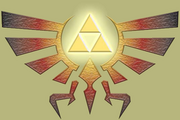
Hyrule Symbol
differently with almost every new game set in it. Parts of Hyrule found in one game's map may be in a different location, have different geographical features, or be completely absent in another. While some games may take into account the geography in past Zelda games (A Link to the Past and Four Sword Adventures share almost the same Hylian geography) others may completely ignore them (The Minish Cap's Hyrule bears almost no resemblance to any other game). Several fan explanations have been given. The first is that the changes occurred because of geological events between the games such as earthquakes, mudslides, erosion, forest growth, continental drift, or all of the above. The second theory is that Hyrule's geography stays relatively the same but that each new game shows the same Hyrule seen from a different angle, that landmarks are renamed, or that other unseen parts of Hyrule are seen each game. Some fans argue that while Hyrule does change from game to game it is simply due to gameplay
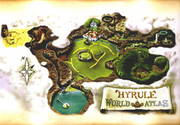
Hyrule Map
reasons to give players something new to explore while staying in the same land and has no real in-game explanations.
It is also possible that different parts of Hyrule are shown throughout the various games. In The Legend of Zelda comics, the map from Zelda II: The Adventure of Link is added to the north of the map found in The Legend of Zelda, and the in-game map for Zelda II: The Adventure of Link also has an area that resembles a scaled down version of the map in The Legend of Zelda. The geography then allows the map from A Link to the Past to be included to the west.
Bridge Worker/Shipyard Worker Theory[]

Bridge Worker
Shipyard Worker from The Legend of Zelda: Phantom Hourglass and may be a descendant of his. Supporting this theory is a picture of the Shipyard Worker found in the Bridge Worker's house.
Cyclos/Golden Chief Cylos Theory[]
It is likely that Cyclos is somehow connected to Golden Chief Cylos from The Legend of Zelda: Phantom

Cyclos
Hourglass. This is likely because they are both similarly named overgrown frogs, who have wind-related powers.
Eox[]
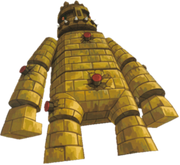
Eox
Eox bears striking resemblance to Golemech, a boss from Star Fox 64. Aside from the idea that they look similar and are the remnants of lost civilizations, they are also both defeated in a similar fashion, crumbling away to reveal weak spots. Because of this, it is possible that Eox was inspired by Golemech.
Force Gem[]
It is theorized that at the end of The Legend of Zelda: The Minish Cap, the Light Force may
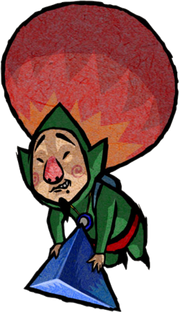
Force Gem
have been fragmented into the Force Gems used to power up the Four Sword in Four Swords Adventures. According toHyrule Historia, the Light Force contains a huge amount of the force that dwells in all living beings. This also supported by how it has the same name in Japanese as the Light Force and the Life Force.
It should also be noted however, that Zelda still has at least a portion of the Light Force, which was noted by Ezlo himself. It was also hinted by Ezlo (in the Japanese version) that the amount Zelda has was the reason (along with her kindness) for the miracle the Minish Cap created towards the end. The Light Force is also theorized as the reason for Zelda's natural mystical powers, which is heavily hinted to be hereditary in nature. The Japanese version also stated that the Light Force is a "limitless" thing of "magic" rather than a force of life.
In The Legend of Zelda: Phantom Hourglass, Force Gems are similarly described as a manifestation of life force. As the story in Phantom Hourglass mostly takes place in the World of the Ocean King, that could explain the Force Gem's presence there. It should be noted however, that the Force Gems also appear in Spirit Tracks, which implies it actually is a thing in Link's world (and not just the land of Hyrule) as the game itself took place in New Hyrule. Since Carben stated that a Force Gem can be created when someone feels powerful emotions, this further disproves that the Light Force and Force Gems are the same.
Force Gems also bear some resemblance to the Triforce, as both are triangles and contain the word "force" in their name. However, there is no known connection between them.
Also, if Carben is to be believed that Force Gems appear when a person feels strong gratitude, then it is possible that the Gratitude Crystals in The Legend of Zelda: Skyward Sword might be a variation on them.
Four Knights of the Cobble Kingdom[]
It is likely that the Four Knights of the Cobble Kingdom are based off of the Carpenters from

Four Knights of the Cobble Kingdom
previous games. This seems possible because there are four knights and four Carpenters, and the knights serve under King Mutoh, while the carpenters work for Mutoh. In addition, the names of the four knights are very similar to the names of the carpenters as they appear in The Legend of Zelda: The Minish Cap.
Ghost Ship(Dungeon)[]
It is possible that the Ghost Ship's design is based on the Ferry to the Other World from The

Ghost Ship(Dungeon)
Legend of Zelda: Ocarina of Time. Both ships have a figurehead with two hands holding bells beneath it, and both ships are structured around the theme of death.
Golden Chief Cylos[]
It is possible that Golden Chief Cylos is somehow connected to Cyclos and Zephos from The

Golden Chief Cylos
Legend of Zelda: The Wind Waker. This is likely because they are all overgrown frogs who seem to have wind-related powers. Also, Phantom Hourglass and The Wind Waker take place in the same timeline, which furthers this theory.
Hero's Clothes[]
Because the Link in The Legend of Zelda: Skyward Sword was the first hero chosen by the Gods,

Hero's Clothes
and the knights are seen wearing the Hero's Clothes, it is possible that this is where they originated from, and from this Link they have been passed down. It is more likely however, that the Hero of Time was the one who passed down the idea as shown in Wind Waker and Twilight Princess.
Ho Ho Tribe[]
It is possible that the Ho Ho Tribe was inspired by Old Man Ho Ho, a character from from The Legend of Zelda: The Wind Waker. Some people also believe Old Man Ho Ho is a part of the Ho Ho tribe.
Jolene[]
A character from The Legend of Zelda: Spirit Tracks, the Take 'Em All On Proprietor, resembles

Jolene
Jolene and may be her descendant.
Linebeck[]
It is never made clear whether Linebeck comes from the World of the Ocean King or the same

Linebeck
world as Link. Although Link first meets him in the World of the Ocean King and he has somewhat of a history there (as indicated by the people on Mercay Island and Jolene), at the end of the game he and his ship are sent back to the Great Sea along with Link and Tetra. It is also noted that when near the end of the game, when the Ocean King, in his whale form, tells that they are in a different world, it is clear that Linebeck appears surprised to hear the statement, suggesting that he is from Link's world. However, this is contradicted by his relationship with Jolene, as she appears to be from the World of the Ocean King. It could be that he is from Link's world, but arrived in the Ocean King's world a long time before Link did. He eventually returned to Link's world, as shown when Link spots his ship after he returns along with his grave found in New Hyrule in the sequel.
Link[]
Reincarnation[]
A common theory as to why each incarnation of Link looks similar and have similar abilities is
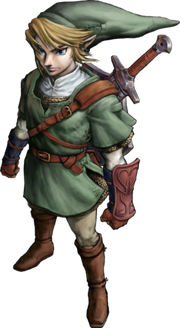
Link
that they are reincarnations of one another. It is notable that when Demise put a curse onto the Skyward Sword, Link, and Zelda, he stated "Those like you... Those who share the blood of the goddess and the spirit of the hero." which may have been referring to reincarnation. It should be noted however, that Link from The Wind Waker could not be the reincarnation of the Hero of Time since the latter went to the Child Timeline and effectively disappeared from the Adult Timeline. According to the King of Red Lions, the Hero of Winds has no connection to the Hero of Time, though it is unclear whether he is referring to blood relation or reincarnation with this statement. It is worth noting that Ganondorf believes the Hero of Winds is the Hero of Time reborn, though his claim has no concrete evidence. Link from Twilight Princess also could not be the reincarnation of the Hero of Time since, according to Hyrule Historia, he not only met the Hero of Time as the Hero's Shade, but is however his descendant.
Relatives[]
Another theory as to why each incarnation of Link looks similar to one another is that they are actually related to one another. This is supported by the fact that the Hero of Time is the ancestor of Link in Twilight Princess as well as how it is stated in A Link to the Past that the Master Sword can only be pulled out from its pedestal by the ones who carry the bloodline of the Knights of Hyrule. It is possible that when Demise stated "Those like you... Those who share the blood of the goddess and the spirit of the hero," when he put a curse on Link and Zelda, he was actually referring to the "spirit of the hero" as a form of will or a set of personality traits rather than the soul itself. If this is the case, this could explain each Link's connection with the Triforce as well as their abilities in physical, mystical, and spiritual ways.
This may mean when he was stating "Those who share the blood of the goddess" he was referring to Skyward Sword Link and Zelda's descendants as the other incarnation of Links rather than the Royal Family of Hyrule, where an alternate reason for the Royal Family having magical powers is the Light Force as hinted in The Minish Cap. This would explain why Link faces other adversaries aside from Ganon, with Zelda (or other members of the Royal Family) sometimes not being present to support the side of good in games such as as Majora's Mask, Link's Awakening and Tri Force Heroes The original Japanese text that Demise states is that his hatred and the Demon Tribe will go under an "evolution", which may mean the curse could involve other villains apart from Ganon himself.
If each Link is related to one another, they need not be related along a single line of descendants. For example, the Hero of Winds cannot be a direct descendant of the Hero of Time since the latter returned to the Child Timeline immediately after his victory over Ganon while being a young preteen in a teenager's body, but provided the Hero of Winds can trace his lineage to Skyward Sword Link, the theory still holds. It is possible that the reason why the Master Sword can only be pulled from it's pedestal by someone who carries the bloodline of the Knights of Hyrule is actually a sub-conscience decision by Fi, who is the spirit of the Master Sword.
Madas[]
It is possible that in the contemporary Hylian language during the events of Skyward Sword, Link's name may be "Madas" when pronounced. This would explain why Fi, when talking to Link in dialogue that uses his name, often says "Madi Madas" with "Madi" possibly being "Master" in the language. Alternatively, it is possible that Fi's words are gibberish used repetitively in the game, similar to Midna in Twilight Princess.
Mako[]
Interestingly, there are many similarities between Mako and Shad, a member of the Resistance
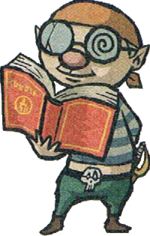
from The Legend of Zelda: Twilight Princess. Both wear circular eyeglasses, and keep a small dagger in their books. This may be more than an allusion; Mako is a member of Tetra's pirate crew who are implied to be the descendants of the royal servants. Shad is one of the members of the Resistance, who indirectly serve the Royal Family, and according to the game's official strategy guide, his father worked as a butler in the royal palace. It is plausible that the two could share a common ancestor, or could be the same person in the parallel universes. Also, Mako is a species of salt-water shark, and a "Shad" is a species of fresh-water fish, possibly alluding to their differing moral values.
Maritime Defense Force[]
The Maritime Defense Force is rarely mentioned, and the identity of the "boss" that Nyave refers to is unknown. Although the leader of the force may very well be a character who is never seen, it is possible by the way Nyave talks about him, that his brother, the Self-proclaimed Hero, is the leader of the Maritime Defense Force.
Multiple Ganon Theory[]
The Multiple Ganon Theory is the theory that there exists more than one Ganon/Ganondorf in the Zelda timeline, in much the same way that Link and Princess Zelda exist as more than one person throughout the Legend of Zelda series. Variations include ideas that Ganondorf is locked in the same cycle of reincarnation as Link, or that Ganon is a malevolent demon who possesses people, Ganondorf being one such host. Supporting the reincarnation idea, it is said by the Gerudo that only a single male is born into their tribe every one hundred years. Depending on the game, he is said to be destined to become either the King of the Gerudo or the guardian of the desert and the Gerudo.
Although the theory has been around for quite some time, most modern versions of this theory stem out of Ganondorf's back-story in The Legend of Zelda: Four Swords Adventures, which conflicts with Ganondorf's back-story in The Legend of Zelda: Ocarina of Time. In Four Swords Adventures the Gerudo talk about a man named Ganondorf who had been born and lived in the Desert of Doubt with them. They mentioned that he had grown into an evil man with a lust for power and had broken their laws by stealing a Trident deep in the desert that gave him incredible powers, such as transforming him into Ganon.
This is in direct contrast to the back-story Ganon was given in Ocarina of Time, in which he is acknowledged by many as the king of the Gerudo, and does not become Ganon until acquiring the Triforce of Power. Additionally, the back-story of The Legend of Zelda: Twilight Princess, which explains the actions of the Ganondorf from Ocarina of Time in an alternate timeline, says that a tribe of thieves, most likely the Gerudo, followed him in his attack on Hyrule, again showing that he was accepted as king.
There are only three logical explanations to these conflicting back-stories:
One is that a single Ganondorf had ventured to the desert and stolen the Trident, broke out of the seal he was placed at at the end of Four Swords Adventures but was not killed by Link, turned back into Ganondorf, and returned to the Gerudo later at a time that they were willing to acknowledge him as king. This would require that Four Swords Adventures take place before Ocarina of Time. The second explanation is that the game is not part of the overall storyline within the series, though official statements indicate that all the games from the main series are included in the official timeline document. The third explanation is that the Ganondorfs from the two games are separate incarnations, much like the many Links, Zeldas, and other characters who are seen multiple times throughout the series. This theory is supported by a quote at the end of Four Swords Adventures in which Princess Zelda calls Ganon an "ancient demon reborn". This is similar language to a line in The Legend of Zelda: The Wind Waker in which Ganondorf calls the game's incarnation of Link "The Hero of Time, reborn". Another solid point for this theory is the apparent death of Ganondorf/Ganon five separate times throughout the series. An individual Ganon is only shown to be resurrected once. Even with this resurrection, and the split timeline allowing a single individual Ganon to die twice, there would still need to be three separate Ganons in order to account for all of the presumed deaths. In order for all of the Ganons in the series to be the same, Ganon would have to have been brought back to life on two additional occasions not hinted at by any of the games, or survived at least two of his apparent deaths.
In The Legend of Zelda: Skyward Sword, Demise states that his hatred will be reincarnated and attack in a cycle without end. This is often interpreted as meaning that Ganon's repeated appearances are a result of this cycle. If Ganon as we know him is a result of Demise's hatred continuously reincarnating itself, there would be further support for the idea that multiple Ganons could continue to appear even as previous ones are slain. This would support the Multiple Ganon Theory as each Ganon would be a separate incarnation in this cycle, though all of them would share the same basic origin of forming from Demise's hatred.
While the Multiple Ganon Theory has yet to gain wide spread acceptance, it has nonetheless gained the respect of some timeline theorist and fans of the series.
Shigeru Miyamoto has stated that although each Link and Zelda are reincarnations, there is "only one Ganon". However, this statement may now be outdated or may have been made based on a lack of information, as Miyamoto is no longer as involved with the Zelda storyline as he previously was.
According to the Hyrule Historia, a second Ganondorf is born during the events leading to Four Swords Adventures. The book either implies or states directly that the rest of Ganon's appearances are the same being brought back to life, or versions of him in alternate timelines.
Niko[]
Some fans speculate that Niko could possibly be descended from the Royal Family of Hyrule. He is a close friend of Tetra, a proven descendant of Princess Zelda. He also closely resembles a man from a painting of the Royal Family, found in Hyrule Castle in The Wind Waker. Also, many of the other members of the Royal Family resemble other members of Tetra's Pirates, and both groups include seven members each. It is possible that at the time of the Great Flood, everything that the Royal Family had was destroyed. Having nowhere to go, they may have built a ship and became pirates.
Pols Voice[]
Pols Voice bear a resemblance to the Bunny Hood, a recurring mask in the series. This may not
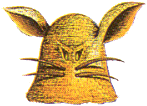
be a coincidence, however; when Link sells the Bunny Hood to the Running Man in The Legend of Zelda: Ocarina of Time, he states upon receiving the mask, "I bet with those long ears you can hear the voices." This quote may very well signify a connection between the Pols Voice and the Bunny Hood. He also states that Hyrule Field once was full of rabbits, but they are now extinct. This could also be a reference, as the Pols Voice look somewhat like rabbits.
Postman[]
It is heavily implied that a member of the Rito tribe in The Wind Waker, Koboli, is a
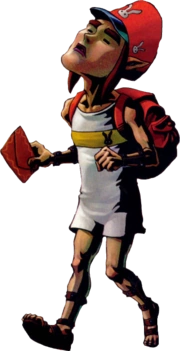
descendant of either the Running Man of Ocarina of Time or the Postman of Majora's Mask. This is due to the obvious similarities in facial appearance. Koboli's occupation also suggests that he is a descendent of the Postman; the text from the Nintendo Gallery explicitly states that he belongs to a family that has been of the mailing profession for generations.
Princess Zelda[]
The relationship Zelda has with Link is close, possibly her closest. A popular theory among
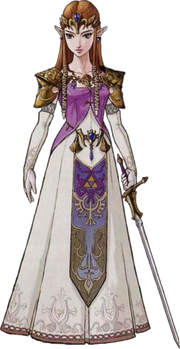
fans is that of a romantic relationship between some of the Zelda and Link characters in the Zelda series. Although never explicitly confirmed in a video game title, this theory is based on hints given in the games, interviews with the game creators, and content of the animated series, comics, and manga (although the last three are generally considered non-canonical).
One hint of a romance between Zelda and Link is given at the end of The Adventure of Link, when the awakened Princess apparently kisses Link under the falling curtain.
Some cutscenes in Ocarina of Time featuring the two together have been interpreted as signs of an attraction. While Link and Zelda are escaping Ganon's Castle, Zelda will additionally show her concern for Link by shouting out whenever he is hurt. Moreover, in the game's final scene, Zelda and Link are floating in the sky together, sharing a decidedly sentimental (if not necessarily romantic) moment where Zelda apologies for involving Link in the events of the game and seems saddened by the situation. She also stated that she will not forget the time she spent with him in the Child Timeline as shown in Majora's Mask through Link's memory.
In addition, if the Oracle games are played as sequels to each other, the ultimate ending sequence shows Zelda lightly kissing Link on the cheek. Link swoons while hearts float above the pair's heads, and Zelda looks away, blushing. In The Wind Waker, when Zelda is asked to stay in hiding in Hyrule Castle while Link restores power to the Master Sword, she waves goodbye to Link, asking him to be careful.
Spirit Tracks features several moments that can be interpreted romantically. Early in the game
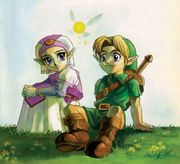
during the Graduation Ceremony, Zelda walks into the room in front of Link, who is bowing down respectfully. Link then looks up and gasps, blushing at her in amazement. He is then scolded by Chancellor Cole for raising his head without permission. Later, when Zelda's spirit is separated from her body following the first encounter with Chancellor Cole and Byrne, Link is the only one who can see her besides the Lokomos, demonstrating a clear and strong bond between himself and the Princess. After Zelda and Link defeat Byrne in the Tower of Spirits, Byrne, disbelieving, comments that he was beaten by two humans. Zelda, while still possessing a Phantom, says that when she and Link combine their strength, no one can defeat them. Link turns to her, surprised. The background turns white and Zelda's Lullaby plays as they both laugh and high-five, gazing at each other all the while. Toward the end of the game, before the final battle against Malladus, Zelda is reunited with her body, and is no longer able to levitate. Link runs underneath her to catch her as she falls, and she lands on top of him and knocks them both to the ground as well as knock Link out for a few seconds. Upon awakening, Zelda, overjoyed to have her body back, embraces Link, causing him to blush. Finally, after Malladus is defeated, Zelda and Link watch Anjean and Byrne's spirits ascend to the heavens. The camera then lowers to show Zelda and Link holding hands while Zelda's Lullaby plays in the background. After the credits, a short cut scene shows Zelda gazing at a picture of Link on the Spirit Train with her flying beside him, which she keeps on her desk. she may also wave at Link depending on his answer to a question Zelda asked before.
Skyward Sword has several noticeable romantic moments between Link and Zelda. Early in the game, Zelda wants Link to be the first to see her outfit for the Wing Ceremony. She worries over him and she does not want him to fail at becoming a knight. When Link's Crimson Loftwing is hidden by Groose, Zelda assists Link in finding his Loftwing. After Link wins the Wing Ceremony, Zelda jumps off the ledge and Link catches her almost as if she was expecting him to. She then congratulates him on winning. Afterwards, Zelda mentions that she is very happy to be atop the Statue of the Goddess with him. She also gets extremely close to him and almost implies that the two are to kiss, before she pushes him off the statue. Afterward, Zelda bashfully asks Link to go out flying which they do. She then tells Link how amazing the day was, and that she would remember it forever. At the Temple of Hylia, when Zelda states she must seal herself to keep Demise in place, she sheds tears of sadness and states before all this, she was happy just being with Link on Skyloft, demonstrating a deep level of feelings for Link. Link desperately tries to stop her and when she is sealed, Link lowers his head in sadness, showing his deep feelings for her. Much later in the game, when Link releases Zelda from her sealed state, Link runs up and catches her from falling and both of them hug and walk out smiling at each other, holding hands, before Ghirahim ruins the tender moment. During the ending, Zelda asks what Link will do now. Link sweetly smiles at her while their Loftwings fly off toward the sky, implying that he chose to stay on the Surface to live with Zelda.
A Link Between Worlds features some gossip told to Link by the Rumor Guy. He tells Link that one of the castle staff had seen Zelda sneaking off every night. When she followed her, she saw Zelda staring at the painting in Hyrule Castle depicting the Link and Zelda from A Link to the Past cuddling with each other, implying they became more intimate with each other. This also hints the Zelda in A Link Between Worlds wants to have a similar relationship with the Link of her time.
The game creators also seem to be fond of the idea of romance between the characters.[1]
Though never directly stated in-game, Shigeru Miyamoto revealed in an interview conducted by Famimaga 64 that Navi is jealous of Princess Zelda and has feelings for Link.[2]
Another less popular theory among fans is that Link and Zelda are related by blood, either as siblings or more distantly. Even though rumors to this effect started with the infamous "Save the Princess... Zelda is your... ... ..." line from A Link to the Past (later reported as a mistranslation), the theory generally revolves around the Link and Zelda from Ocarina of Time.
A possible indication of a blood relation between the two in Ocarina of Time is their physical resemblance: they both have blonde hair, blue eyes, and similar facial features. They also have similarly shaped heads. Graphics limitations could be responsible for some of this similarity, however. Certain dialogue could also be perceived as implying a blood relation: the ghost Sharp comments that Link reminds him of Zelda, and that Link "may have some connection with the Royal Family".[3] Link's connection to the Royal Family is highlighted throughout the game, with Link often playing Zelda's Lullaby to verify it. The fact that Impa agrees to teach a strange boy a song only Royal Family members are allowed to know could also be interpreted as a hint at Link's blood relation to Hyrule's Royal Family. [4]
Additionally, Zelda seems to recognize Link's name upon their first meeting.[5] This could be attributed to her prophetic abilities, although the boy in her dreams seemed to be a largely abstract figure, with no defining traits aside from the presence of a guardian Fairy and a Spiritual Stone. This line of dialogue has often been regarded as a sign that the two have met before, although this could only have occurred when Link was a baby per the Deku Tree Sprout's account of Link's coming to Kokiri Forest. It is also worth noting that while the King of Hyrule is clearly identified as Zelda's father, no mention is made of a Queen. Meanwhile, Link's mother is stated to have died shortly after reaching the forest, but no information is given concerning his father. Given these facts, it is possible that Zelda and Link share the same parents, making them siblings.
Split Timeline[]
It is speculated by some that alternate worlds such as the Twilight Realm and Termina may be unaffected by the timeline split. However, while these two realms are alternate dimensions, there is no evidence to support the idea that they exist outside of linear time. Both realms have demonstrated the ability to receive beings from the Child Timeline and return them to the Child Timeline when they exit back into Hyrule. There is no reason to believe that these two realms would only exist as a single timeline, or that they could "prioritize" inputs from one timeline, and later output these into both the timelines.
In addition, the renowned Youtube show, Game Theory, dismissed the Zelda Timeline, particularly the Defeat Timeline (in where Link fails on his quest) on the grounds that "the hero cannot be simultaneously victorious and defeated". Elaborating, he explained that with Link defeating Gannondorf, two perfectly possible timelines are created; However if Link dies at any point in his journey another separate timeline is created. Explaining that the only way for all 3 timelines to exist is the Many Worlds Theory (the theory that all possible pasts and futures exist in separate timelines).
Take 'Em All On Proprietor[]
The Take 'Em All On Proprietor bears a striking resemblance to Jolene, a pirate from The Legend

of Zelda: Phantom Hourglass, and may be her descendant.
Tigle[]
A character named Purlo appears in The Legend of Zelda: Twilight Princess. Purlo is possibly a
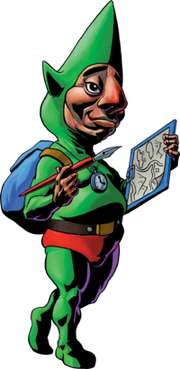
reference to what Tingle would look like if he was a more realistic character. Purlo is the manager of the STAR Game in Hyrule Castle Town, and he wears a similar costume to Tingle. He is also obsessed with Rupees, much like Tingle. Unlike Tingle though, Purlo has an unfriendly attitude towards others.
